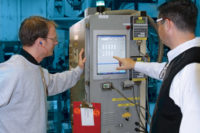NEW YORK — Merger and acquisition activity in the industrial manufacturing industry got off to a healthy start in 2015, recording the strongest first quarter deal value in four years, according to Assembling Value, a quarterly analysis of global deal activity in the industrial manufacturing industry by PwC US.
The first quarter totaled $19.9 billion in announced transactions (worth more than $50 million), despite a notable pause in U.S. deal making — largely attributed to volatility in commodity and currency prices.
In the first quarter of 2015, there were 48 manufacturing transactions (worth more than $50 million), almost 15 percent below the previous quarter, but exceeding the 37 deals recorded in the first quarter of 2014 by almost 30 percent. The $19.9 billion deal value represented a 76 percent increase over the $11.3 billion in the same period last year. In addition to having the strongest first quarter for deal value in four years, deal volume hit the highest first quarter level in the last 10 years.
“Coming off of a stellar close to a very active 2014, we saw continued interest in M&A among manufacturers during the first quarter of 2015,” said Bobby Bono, U.S. industrial manufacturing leader for PwC. “While U.S. investors took a bit of a back seat to start the year, PwC’s Q1 Manufacturing Barometer found that optimism regarding the direction of the U.S. economy continues to rise, despite growing uncertainty around the potential impact of the strong dollar. The U.S. share of global activity dropped to among its lowest levels in a decade as deals involving energy assets declined from the robust level in 2014. Moving forward however, the strong dollar could help drive U.S. outbound deals as foreign targets become cheaper in U.S. currency.”
While there were few headline grabbing megadeals (transactions worth more than $1 billion) in the first quarter, five of these transactions accounted for $8.9 billion (48 percent) of total deal value. According to PwC, many executives completing these large deals were motivated by the desire to gain scale, operational efficiency, and to drive profitability in regions plagued by overcapacity. The rationale behind other megadeals included portfolio expansion, with a focus on customer base expansion and the desire to meet emerging customer needs.
As cross-border deal activity dropped to 25 percent of the global total, the lowest in at least 10 years, transactions by emerging market acquirers surged to nearly 60 percent, well above recent levels. Of the 48 transactions in the first quarter of 2015, 28 were driven by emerging markets acquirers and of those, 27 involved China. “As we have noted in the past, heavy transaction activity in China continues to be driven by consolidation among smaller, niche companies and restructuring initiatives that are underway in the region as Chinese State Owned Entities are in the process of privatizing,” Bono continued.
PwC’s industrial manufacturing M&A analysis is a quarterly report of announced global transactions with value greater than $50 million analyzed by PwC using transaction data from Thomson Reuters.
For more information on PwC’s Deals practice, visit www.pwc.com/us/deals







